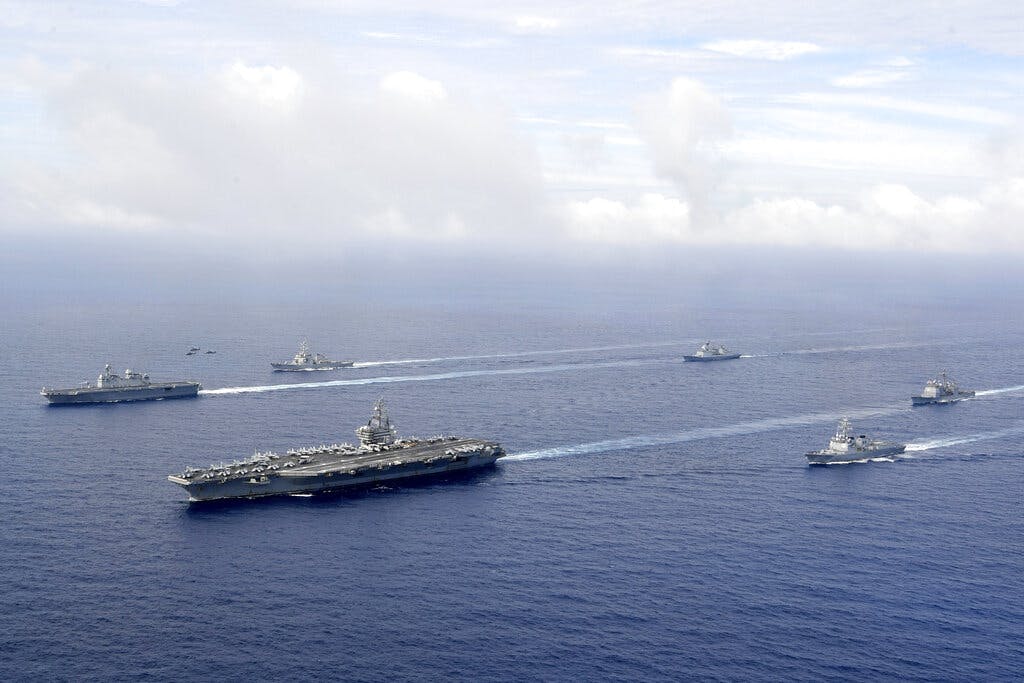As American Navy Struggles, Chinese Set To Commission Third Aircraft Carrier and Bulk Up Its Network of Foreign Military Bases
The launch of the Type 003 ‘will be a seminal moment in China’s ongoing modernization efforts and a symbol of the country’s growing military might.’

In yet another indication of Communist China’s global ambitions, Beijing appears poised to launch its third aircraft carrier, and lawmakers in Washington are not happy — warning that unless America steps up its investments in the Navy, it will be left behind on the open seas.
The development of the carrier, dubbed the Type 003, was first noticed on satellite imagery in 2018. Progress on the project slowed during the Covid pandemic, but newly released imagery suggests that the carrier will now likely be completed by the end of June.
The Type 003 is comparable in size to the USS Gerald Ford, the largest American aircraft carrier in existence. While the two are similar in appearance and size, the Chinese Type 003 is conventionally powered and is the second aircraft carrier domestically produced by China.
“Although it will be years before the Type 003 enters military service and achieves initial operating capability, its launch will be a seminal moment in China’s ongoing modernization efforts and a symbol of the country’s growing military might,” a senior fellow on the China Project at the Center for Strategic and International Studies, Matthew Funaiole, said.
According to official Chinese press reports, the carrier will have cutting-edge technology that even American carriers do not possess, including three electromagnetic launch catapults to more efficiently launch planes than current technology allows and a capacity for 40 aircraft between its decks.
The carrier is to be used in China’s goal of achieving a blue water navy that can venture further from the mainland.
“We need to sail to more unfamiliar waters, face more complicated weather and sea conditions in more complex missions, and have more accompanying force,” the captain of the Chinese carrier Shandong, Xu Ying, told the official Global Times newspaper.
The unfamiliar waters Captain Xu alluded to likely include the Gulf of Thailand and Cambodia, where, according to the Washington Post, Communist China and Cambodia have signed a secret military agreement that would allow China to construct a naval base in the city of Ream, originally the base of the Cambodian navy.
A Cambodian hub would be China’s second foreign military base, after Djibouti in the Horn of Africa.
The new prime minister of Australia, Anthony Albanese, said his country’s officials have been aware of Beijing’s activity at Ream for some time. “We encourage Beijing to be transparent about its intent and to ensure that its activities support regional security and stability,” he said.
With China expanding its military footprint in southeast Asia and the Pacific, American policymakers are expressing concern that America is not taking the steps necessary to compete with China in the region.
In a recent report, the Center for International Maritime Security’s Matthew Hipple said America’s shipbuilding plan for fiscal 2023 “proposes a 10-year drop in fleet numbers that deviate in spirit from every shipbuilding plan since 2012.”
In budget presentations to Congress several years ago, Navy officials said: “About 300 ships, achieved in FY2018, will provide a force capable of … assuring access in any theater of operations, even in the face of new anti-access/area-denial strategies and technologies.”
More recently, however, the Navy has indicated that it will have to shed ships in the 2020s due to poorly designed versions like the Navy’s Littoral Combat Ships. Nine such ships, which together cost more than $60 billion, are set to be scrapped.
The Navy also has projected a slowdown in shipbuilding in the 2030s, due to cost constraints among other issues.
This follows a report that Navy recruiters are going to see a decline in enlistments in coming years, hampering future development.
“We are getting close to the tipping point where the only option is to go into full triage mode for the service, and Congress needs to lead us in this urgent recovery,” a senior fellow at the American Enterprise Institute, John Ferrari, said.
A House Armed Services Committee member, Representative Mike Waltz of Florida, expressed similar concerns during a recent hearing. “These budgets are setting us up to lose against China,” he said of the Navy.
Others have downplayed such concerns.
Writing in the National Interest, Kris Osborn said, “Without the ability to achieve air superiority or project stealth power from the air, an additional Chinese carrier isn’t likely to be impactful in any great power conflict.”

